By Christina Ameln, CSR | Sustainability Advisor –
The Rat is the first of all zodiac animals which seems appropriate as we move into 2020 – and a new decade. According to one myth, the Jade Emperor decided that the zodiac order would depend on the order in which animals arrived to one of his grand parties. The Rat jumped the queue in the last minute and came first. And in terms of yin and yang, the Rat is also associated with the start of the day.
As we kick-start this new decade and welcome the year of the Rat, I am reflecting on the sustainability goals for the next 12 months.
Put simply, I want to see more of what I have seen in Southeast Asia in the last year. In over 20 years of working on social impact for corporates, multilateral and non-profits, these last 12 months seem transformational in many ways. We have seen greater engagement on a range of issues, including impact; supply chain; moving CSR to be more strategic; community engagement; climate change; circularity, waste and plastic; and innovation. Not only do I hope to see more of this, I hope the commitment and results will accelerate. In addition to my daily consultancy, I have tried to jump-start awareness of and attention to these issues on my knowledge-sharing platform www.SustainableVietnam.com. I will re-double my efforts in the months to come.
This preoccupation has involved a lot of coffee… which might sound strange coming from a tea drinker.
A lot of what I do as a sustainability and CSR consultant and project manager is in fact about coffee. Coffee is usually taken at the start of the day, similar to what the zodiac sign the Rat is associated with. That first coffee meeting sets in motion many interesting interactions and projects small and big. And I am all about solving puzzles and creating connections in sustainability.
This shift to coffee is probably a combination of my past and present. Sweden, my home country, is often cited as one of the top three countries worldwide in per-capita coffee consumption; and Vietnam, where I work, is often cited as one of the world’s top three producers and exporters of coffee.
The Force of Impact
Over these many coffee sessions, I have come to view 2019 a year of rapid movement. I am excited by the increased use of the word impact, especially in the finance sector. This sector has traditionally been seen as an odd bedfellow to sustainability – but the concept of impact investing has taken a firm grip on the region.
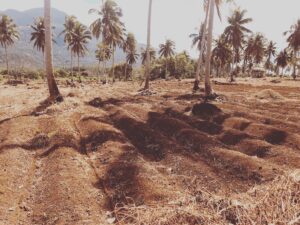
Impact Investing in the Philippines – making an island self-sustaining by strengthening farming practices.
I was lucky to see the results of impact investing first-hand during a trip to the Philippines early in 2019. I met a young woman leader who is working hard to turn around the agribusiness of one island to make it self-sustainable. She is engaging with local farmers to elevate local agricultural production and demonstrating the market value of local crops such as turmeric, long considered a weed in her community. The aim of this partnership between investor and agribusiness is to move it to the next phase and increase social impact as well as financial returns, with benefits for all stakeholders.
- Sustainability is Going Mainstream & Investors are Playing Their Part
- What Does Social Impact Mean for Corporations?
- Sustainability Builds Efficiency & Vice Versa: A Chat with Johan Bygge, Chairman EQT Asia
Supporting this type of initiative is a regional organisation known as AVPN. In addition to championing and creating links for and among their members – which includes corporates, investors, foundations, and philanthropists – AVPN mobilizes more strategic, collaborative and outcome-focused approaches to social investing. In doing so it addresses key social challenges in Asia today and in the future.
The organisation is a force to reckon with. I saw this first-hand at their annual event that brought close to 1,500 people from all sectors – regionally and internationally – to Singapore last June. I also witnessed throughout last year how it galvanises impact in a wide range of markets.
- AVPN 2019 Conference
- Catalyzing Engagement on Climate Action
- Turning the Growl of Hunger to a Purr of Sustainable Nutrition
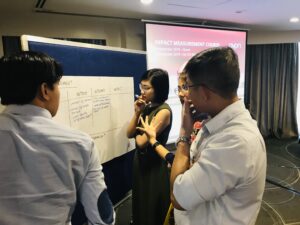
Measuring Impact course hosted by AVPN in Vietnam.
Still, a number of challenges to impact remain. Impact advocates continue to struggle to find the right match and credible partners, to establish sustainable and convincing foundations, to accelerate progress and to measure impact. This last point was clear in the recent workshops that I held with AVPN in Vietnam on Measuring Impact. The challenges can be daunting – but they can be met.
I am also cautious about the use of the word impact– it needs to be sound, sustainable and make a difference aimed at positive effects in communities and environments. If used casually or inappropriately, e.g., to ‘green wash’ and/or skip corners with projects that don’t meet standards or reporting foundation, it damages the credibility of the concept. In any case, those initiatives usually show their true colours early on and often can leave a bitter taste for everyone involved (in the same way that coffee can be too strong).
A final note: while some might think impact and sustainability are the purview of a selected few, I will continue to argue otherwise. Sustainability is everyone’s business.
We can all make a difference.
The Sustainability of the Supply Chain
Supply chain in Vietnam continues to dominate, especially with the increase of the China-US trade war which saw many companies looking to Vietnam to continue to expand the manufacturing presence in the region without impacting their margins. While there is still a discrepancy between local manufacturing companies and foreign-owned ones, ensuring that factories comply to international social and environmental frameworks is still very much a priority.
The next wave of those engaging in the supply chain is to cement the sustainability work further down the chain with all business partners where they own that responsibility versus always seeing it as part of social or environmental checklist. Working with an international organisation and an MNE furniture company, I was impressed on how this company was taking the lead to embed the Sustainable Development Goals (SDGs) further into their supply chain. Instead of the concept sitting only at headquarters, it encouraged local business partners to take ownership. This company took sustainability in the supply chain to the next level.
Other conversations during the year, made clear to me how many companies were moving to new models of manufacturing with the aim to save water, energy, use different materials, recycle etc. Many actors are engaging with communities in more meaningful ways, from talking about disabilities, migrant workers, women in the workforce etc.
All are interested to be ‘ready for battle’ for what the complex social and environmental challenges that are already here and yet to come.
- Eyes on the Ground: IKEA, Sustainability & Compliance
- H&M Southeast Asia Equals Democratised, Sustainable & Available Fashion & Design
- How Dynamic is Sustanability in Asia?
- CSRAsia 2019- Sustainability: From Rhetoric to Results
CSR: The Definition
I now have to break mid-way for a small and important side note. Consider grabbing yourself a coffee as I do so.
Let’s go back to basics on the definition of Corporate Social Responsibility (CSR). Yes, I can agree that there can be singular ways to engage on CSR as each corporate, project, initiative, stakeholders can be different. However, we should not forget that the full spectrum of CSR, whether it is working on a Code of Conduct with your employees or engaging in the community, requires viewing this work as strategic and long-term.
While the concept of CSR has been around for decades, I still see organisations in Vietnam engaging in one-off charity events and describing it as CSR. Others have strong communications and marketing teams that brand questionable actions as CSR. To be honest, many of these boils down to PR-stunts.
CSR engagement requires a thought-process, in the same way as business development, strategy, human resources, etc. It is about building sustainable engagement and a sustainable business. It is acknowledging both your local and international accountability. It is correspondingly having the right teams in place with this thought process of strategic and long-term thinking; and let’s not forget CSR expertise – that is corporate, social and responsibility expertise.
Leading companies understand this and many others are quickly catching up. Those that adopt this thinking in the region will be the trailblazers of tomorrow.
Now back to my continued preoccupation on all things sustainability!
Engaging with the Community
‘While economic growth has lifted millions of people out of poverty, ‘Vietnam’ is still grappling with multiple development challenges, especially malnutrition, health care and climate change’ according to the recent AVPN country report. It is an oxymoron as these days it is not odd that I see a lime green Lamborghini zoom by a Vietnamese trash collector on her bicycle with a traditional conical hat on her head. It is quite a contrast.
As these divides grow, it is important to support local organizations such the LIN Center for Community Development, a Vietnamese non-profit aimed at connecting all sectors to build a resilient Vietnam. With close to 400 local non-profits in its network, it works tirelessly to ensure that local and often smaller community advocates have a voice and those that work on the ground have the same access to resources, connections and knowledge as the bigger organizations in Vietnam.
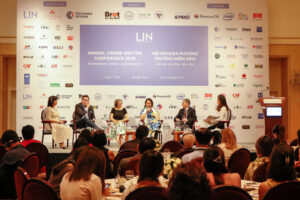
LIN Cross-Sector Conferece 2019 on partnerships, impact and sustainability in Ho Chi Minh City.
In addition to my work with corporates, I am proud to engage with non-profits and international organizations. I sit on the LIN Board of Advisors and moreover helped deliver the third LIN Cross-Sector Partnerships Conference 2019 focused on partnerships, impact and sustainability in Vietnam. It was an event unlike any other in the country and created a lot of positive buzz and even more positive connections and impact.
- LIN Annual Cross-Sector Conference: Partnerships, Impact, Sustainability
- Being a ‘Broker’ For Sustainable Impact
All this buzz is needed. Yes, it is easy to say – “Oh, not another event!”.
Without raising these topics in open forums, many of them would never see the light of day. Many topics are hidden and/ out of sight. Disabilities, violence against women, human trafficking, exploitation of children, anti-corruption, etc. need a platform and all sectors have a responsibility to support in creating a ‘voice’ so those impacted and the topics are heard.
- The Fight Against Corruption Takes a Positive Turn
- How Can We Empower Our Daughters? With Saigon Children’s Charity
- Peace Culture Day hosted by Ho Chi Minh’s Peace and Development Foundation and its president MadameTon Nu Thi Ninh
- Christina Noble Children’s Foundation – 30 Years of Impact
- Business and Women’s Empowerment: Opportunities and Challenges hosted by UN Women and Eurocham
- Building the Eco-System of Philanthropy in Asia
- Dream Big
It is simple to think that this is an issue so far removed that it does not impact you especially if you are sitting across the world in Europe or the USA. I differ in that opinion. In our interconnected world, impacts are now felt across the world.
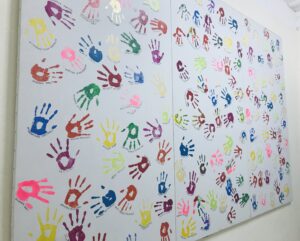
An artwork of hands at Blue Dragon Children’s Foundation centre in Hanoi.
One of the saddest moments in 2019, was learning about the 39 Vietnamese who suffocated to death in the back of a refrigerated truck in England. They had all travelled across continents in search of a better life. On this occasion, this incident made headlines across the world but often no one hears the other stories.
- Why is There Still an Issue with Human Trafficking in Vietnam?
- See, Hear, Speak: Spurring Action Through Communications
My visit to the Blue Dragon Children’s Foundation in Hanoi was even more emotional than it would have otherwise been because news of these deaths had just made headlines. As Founder Michael Brosowski talked about a rescue Blue Dragon had initiated, I cried. Blue Dragon works with street children and human trafficking and on the day of my visit, a young woman who had been trafficked to China some 40 years ago was able to return home to her parents and village because of Blue Dragon’s help. The organization works on all levels and if you are to read anything today – grab some time to read Michael’s article – Why is There Still an Issue with Human Trafficking in Vietnam?
Climate Change, Circular Economy & Waste
An additional topic that has risen precipitously in the ranks is the impact of climate change. All the participants in ELEVATE’s Tracking the Trends 2019, which I contributed input to along with other regional peers, agreed. The results from the region saw that the top three most frequently mentioned topics for 2019 were supply chains, labour and human rights; climate change; and circular economy and waste.
Asia as a region is at risk for climate change impacts in part by its location – there is no point denying it. We are fast approaching disaster.
The ELEVATE report also talks about plastic: “More than half of all plastic waste in oceans comes from just five Asian countries (China, Indonesia, the Philippines, Vietnam and Thailand), placing pressure on national governments in the region to act… The plastic waste crisis is affecting numerous industries from consumer goods to tourism and hospitality, and fashion. As the public discourse matures, there is an increasing understanding of the broader waste management challenges in the region and the need to adopt a circular model that decouples economic activity from the consumption of finite resources and the creation of waste”.
And it is again something that we see all around us here in Vietnam. Those of us fortunate enough to take our children to the beach on holidays see it up close. It all seems so tropical and exotic yet, during the last periods, my husband and I have more than on one occasion prevented our children from swimming in the sea because of the big chunks of plastic and waste floating by. And on many other occasions this last year, they have had to play indoors as the pollution has been so intense.
I say this with genuine concern and sadness.
- Sweden ‘Looks’ Greener From Vietnam
- The Energy Paradox: Schneider Electric on Bringing Light
- Catalyzing Engagement on Climate Action
Innovation
And with sadness, comes action. And in action there is innovation. The word and the actions around innovation has been catalytic in 2019. There are embassies, business chambers, corporates and organizations working on innovation in different formats, from solving a community issue to a corporate conundrum. The innovative in the innovation is how different generations and regions are coming together.
Students and youth, as a key stakeholder in innovation, is something I am looking forward to do more in 2020 with innovation studio Schoolab aimed at putting students from all walks of life in position to work together on real projects of companies. All have a part to play and there is a new generation of young patrons that are interested, concerned, solutions-oriented, creative, and pioneering in their thinking.
For example, the last period saw the Embassy of Sweden to Vietnam working with companies and students around the theme – Innovate Like a Swede. The 2019 ‘Innovate Like a Swede’ student winners were celebrated during the Swedish Embassy’s In the Spirit of Nobel Dinner in Hanoi. I was particularly honored to wrap-up my year as the inspiration speaker at that dinner. I spoke about sustainability and innovation and – What Would Alfred Nobel Think? The word that resonated most with the audience was the word – courage.
And courage is what I will continue to develop during 2020 and the Year of the Rat. I will continue to pursue this passion with determination and energy.
Happy New Year and don’t hesitate to reach out to me with ideas, concerns, suggestions or a cup of coffee.
Together we can lift up these topics and engage on sustainability – small or big!
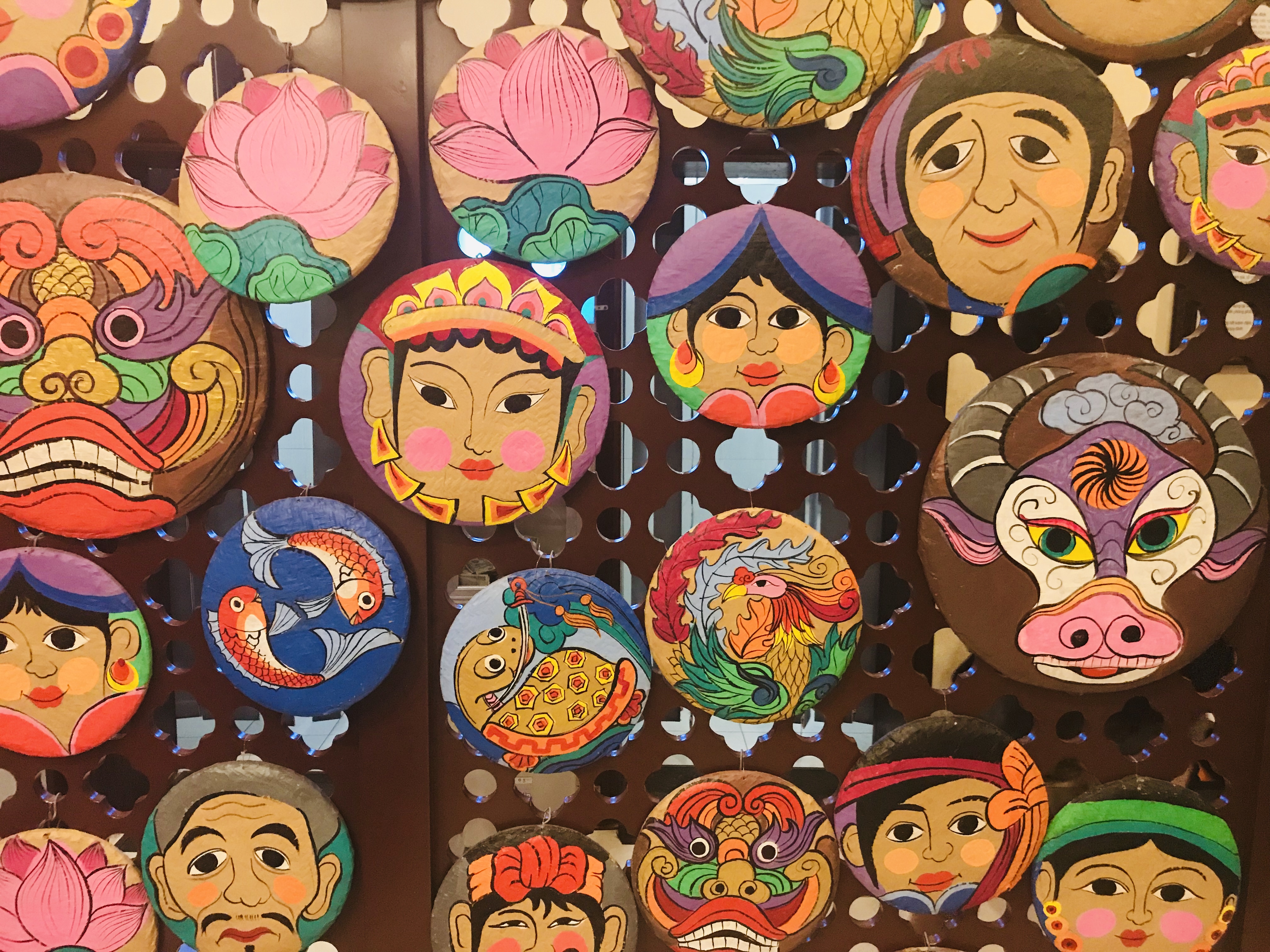


1 comment
Awesome post! Keep up the great work! 🙂